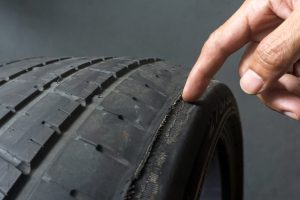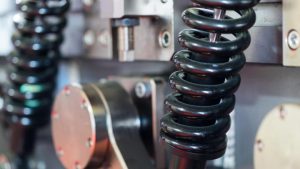Uneven tire wear is one of the most common signs that something isn’t right with your suspension system. While many drivers blame wheel alignment or tire pressure, worn or damaged suspension springs are often the hidden culprit. Springs play a crucial role in maintaining ride height, weight distribution, and tire contact with the road. When they fail, tire wear patterns change — leading to poor handling, reduced tire life, and even safety issues.
In this article, we’ll explore how faulty springs cause uneven tire wear, how to diagnose the problem, and what you can do to fix it effectively.
Understanding the Role of Springs in Tire Wear

Suspension springs support the vehicle’s weight and help maintain the correct ride height. When they compress or expand unevenly, they affect camber, toe, and caster angles — key alignment settings that determine how tires touch the road.
If a spring sags or breaks, one side of the vehicle can sit lower than the other, creating an imbalance. As a result, one tire may carry more load than the rest, wearing out faster or developing irregular tread patterns.
In simple terms:
A weak or broken spring = uneven weight distribution = uneven tire wear.
How Springs Affect Tire Wear Patterns
Different types of spring-related problems lead to distinct tire wear signatures. Understanding these patterns can help pinpoint the issue quickly.
| Tire Wear Pattern | Possible Cause | Effect of Spring Issue |
|---|---|---|
| Inner edge wear | Excessive negative camber | Sagging spring lowers one corner of the car, tilting the wheel inward. |
| Outer edge wear | Excessive positive camber | Broken spring causes the wheel to lean outward. |
| Cupping / scalloping | Poor damping or spring oscillation | Weak spring allows excessive vertical bounce, leading to uneven tread patches. |
| Diagonal wear | Uneven ride height | One spring is weaker than the others, shifting alignment angles. |
| Center wear | Overinflated tires (less spring-related) | Can be worsened by improper spring stiffness or ride height changes. |
Common Spring-Related Causes of Uneven Tire Wear
-
Sagging Springs
-
Over time, coil or leaf springs lose tension, reducing ride height on one side.
-
This changes wheel alignment and increases load on the affected tire.
-
-
Broken or Cracked Coils
-
Even a single broken coil can drastically alter suspension geometry.
-
Causes sudden shifts in camber or toe, especially noticeable during cornering.
-
-
Uneven Spring Fatigue
-
Springs don’t always wear evenly. When one side weakens faster, the car tilts slightly.
-
The tilt affects steering geometry and leads to diagonal or patchy wear.
-
-
Improper Spring Installation
-
Incorrect seating or orientation during installation can misalign suspension parts.
-
Always ensure the spring end fits snugly into its perch.
-
-
Mismatched Springs
-
Mixing different spring rates or lengths can disturb suspension balance.
-
Replace springs in pairs (front or rear) to maintain even handling.
-
Diagnosing Spring-Related Tire Wear
You can identify spring problems through a combination of visual inspection, ride height measurements, and road tests.
Step-by-Step Diagnosis
-
Visual Ride Height Check
-
Park the car on level ground.
-
Measure the distance from the wheel arch to the center of the wheel on all sides.
-
A difference greater than 10–15 mm indicates possible spring fatigue.
-
-
Inspect Springs for Damage
-
Look for cracks, corrosion, or broken coils.
-
Check that both springs on the same axle have equal spacing and alignment.
-
-
Examine Tire Wear Pattern
-
Uneven tread or cupping on one wheel points to spring-related imbalance.
-
-
Bounce Test
-
Push down firmly on each corner of the vehicle.
-
The car should rebound once and settle. Continuous bouncing indicates weak springs or shocks.
-
-
Check for Noises or Leaning
-
Creaking or clunking when driving over bumps often signals spring damage.
-
A visible lean to one side confirms loss of spring tension.
-
Table: Quick Reference for Spring Faults and Symptoms
| Symptom | Likely Cause | Suggested Action |
|---|---|---|
| One corner lower than others | Sagging spring | Replace both springs on the axle |
| Tire cupping or patch wear | Weak spring or shock | Inspect and replace suspension components |
| Vehicle pulls to one side | Uneven spring stiffness | Replace both sides, check alignment |
| Noise when turning or braking | Broken spring coil | Immediate replacement required |
| Uneven ride comfort | Mismatched spring rates | Install matched pair of correct specification springs |
Solutions: How to Fix and Prevent Uneven Tire Wear from Springs
1. Replace Worn or Broken Springs
Never replace just one spring — always replace in pairs to keep suspension balance intact. For high-quality replacements, Buy Springs & Components online for the best fit and durability.
2. Realign the Wheels After Replacement
After any spring replacement, a four-wheel alignment is mandatory. New springs restore proper ride height, which alters camber and toe angles.
3. Inspect Shock Absorbers
Springs and shocks work together. Worn shocks can cause additional oscillation, even with new springs. Check for oil leaks or soft rebound response.
4. Maintain Proper Tire Pressure
Even the best suspension won’t save tires from poor inflation habits. Check pressures monthly and adjust to manufacturer specs.
5. Avoid Overloading the Vehicle
Excess weight compresses springs and can permanently deform them over time. Regularly carrying heavy cargo accelerates spring fatigue and tire wear.
6. Regular Suspension Inspections
Schedule inspections every 20,000–30,000 km or twice per year, especially after rough road driving or winter use.
Preventive Maintenance Checklist
| Maintenance Task | Frequency | Purpose |
|---|---|---|
| Visual spring inspection | Every 6 months | Detect early corrosion or cracks |
| Ride height measurement | Every 10,000 km | Identify sagging or uneven spring tension |
| Alignment check | After spring replacement | Restore correct geometry |
| Cleaning undercarriage | Monthly | Prevent corrosion and debris buildup |
| Replace springs in pairs | As needed | Ensure balanced suspension response |
Additional Tips

-
Avoid cheap, uncoated springs — look for powder-coated or corrosion-resistant materials.
-
When upgrading, consider progressive-rate springs for better load handling and reduced tire stress.
-
Off-road or heavy-duty vehicles may benefit from reinforced or variable stiffness springs.
If you drive in regions with extreme temperatures or salted winter roads, regular cleaning and protective coatings can dramatically extend spring life.
Summary
Uneven tire wear isn’t always about alignment or air pressure — it can often point to suspension spring problems. When springs sag, crack, or wear unevenly, they distort suspension geometry and compromise tire performance.
To fix the issue:
-
Inspect springs regularly for height, cracks, and corrosion.
-
Replace damaged springs in pairs to maintain balance.
-
Always perform alignment afterward.
-
Choose high-quality replacements — you can conveniently Buy Springs & Components online to ensure proper fit and reliability.
By diagnosing spring issues early and maintaining them properly, you’ll enjoy smoother handling, longer tire life, and safer driving for thousands of kilometers.